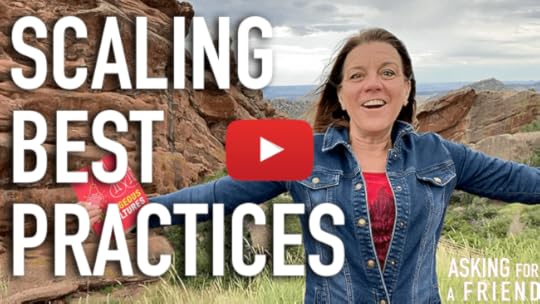David Dye's Blog, page 47
July 15, 2022
Tomorrow Together with David Dye
The 21st century hasn’t started the way that many of us expected it would. We’re looking at a potent mix of a global pandemic, global warming, the resurgence of authoritarianism, white nationalism, and war that again threatens to consume the planet. It can feel frustrating and hopeless. And those are just a few of the issues that are pervasive and in people’s consciousness regularly. Still, with all of that going on, there’s hope. We’ve got the resources, the wisdom, and most importantly, we have one another. Tomorrow Together is a collection of essays by David Dye that highlight moments of wonder, beauty, connection, and friendship. It’s about hope, healing, and humanity. That’s the throughline, the thread that runs through all of them. These essays are really meant to be read and reflected on but are also opportunities to start conversations.
Tomorrow Together Episode TranscriptLet’s try something a little different. Hey, it’s David and you’re listening to Leadership without Losing Your Soul, your source for practical leadership, inspiration tools, and strategies you can use to achieve transformational results without sacrificing your humanity or your mind in the process.
Welcome to season 11 of the show. So glad that you’re here and very excited about season 11 as we get going. I know that you’re listening to this show because you are committed to human-centered leadership and we’re all in progress. We’re all growing, we’re all learning. And I’m so grateful for you for listening and for your leadership, for the difference that you’re making for the people on your team, in your organization, and in the larger world.
Now I want to take a little bit deeper dive into the human or humanity part of human-centered leadership. In season 11 I’m going to continue to bring you some of the guests that you’re accustomed to and some shorter episodes focused on answers to your questions or specific needs that I know are out there.
I also want to use season 11 in a little bit different way, partly centered around a new book that I have coming out, which is not a, strictly speaking, leadership development book. It’s called Tomorrow Together: Essays of Hope, Healing, and Humanity. This is a collection of essays, and let’s be real, the 21st century hasn’t started the way that many of us expected it would. We’re looking at a potent mix of a global pandemic, global warming, the resurgence of authoritarianism, white nationalism and war that again threatens to consume the planet. It can feel frustrating and hopeless. And those are just a few of the issues that are pervasive and in people’s consciousness regularly.
Still, with all of that going on, there’s hope. I believe we’ve got the resources, the wisdom, and most importantly, we have one another. If we can find our way to one another, and these essays are all about that in different ways. They highlight moments of wonder, beauty, connection, and friendship and cover everything from Maryland crabs to donkeys on an island in the south Caribbean, storms on mountains, the help of strangers, odd advice, strong emotions, the miracle of a modern meal, gas stations, travel adventure so much more. But it’s about hope, healing, and humanity. That’s the throughline, that’s the thread that runs through all of them. And so over the course of season 11, I’ll take the opportunity to share a couple of those with you. And if you find them meaningful, I would love if you could pick up a copy of Tomorrow Together, available on Amazon and everywhere else. It’s also available in paperback or eBook and feel free to share it with others. These essays are really meant to be read and reflected on but also are opportunities to start conversations.
Kevin Cruz, who has been on the show before, New York Times bestselling author, and the CEO of LEADx, described the book as filled with love, hard-earned wisdom, and thought-provoking questions. Tomorrow Together is a joy to read and a catalyst for meaningful conversations with friends, family, and the strangers with whom we will build the future.
So there you go, a little bit of a commercial for Tomorrow Together. I hope that you’ll pick up a copy, but I’ll definitely be sharing some of those stories and essays on the show as we go. And I’ll also note as a good friend told me who read it, who’s known me most of my life, still learned quite a bit about me, that he didn’t even know. So, there are those opportunities to, if you’re interested in my story and my journey, there is some of that there as well.
Alright, so I want to start with the first essay in the book, it’s called a together future. And I start with a quote from Carl Sagan. This is from his essay Pale Blue Dot: A Vision of the Human Future in Space.
He says, “the earth is the only world known so far to harbor life. There is nowhere else, at least in our near future, to which our species could migrate visit. Yes, settle. Not yet like it or not for the moment. Earth is where we make our stand.” And I contend that Carl Sagan’s Pale Blue Dot is the most important piece of writing in the 20th century.
He wrote it in response to seeing a view of our planet taken from Voyager one, the satellite that was sent out as it neared the edge of the solar system. So it turns around, it looks back at the solar system that it’s leaving and Earth is a tiny dot of light from the edge of the solar system. That’s all you can see. He says look again at that dot, that’s home. Sagan’s description of all human history of all known life. It’s haunting, it’s humbling, and awe-inspiring that dot, what he calls a moat of dust suspended in a sunbeam is all we have.
Melba Beals was one of the Little Rock Nine, the first nine black students who registered to attend the formerly all-white central high school in Little Rock Arkansas. In her memoir Warriors Don’t Cry she wrote the task that remains is to cope with our interdependence, to see ourselves reflected in every other human being, and to respect and honor our differences and interdependence. It’s one of those words that can mean so much.
John Green describes it easily as all life is dependent upon other life. And the closer we consider what constitutes living the harder life becomes to define in short, we need one another. The only real future we have is one that involves all of us but that’s hard work.
Back when I was a local elected official city council member, one of my assignments was to represent our city on a task force, dedicated to four miles of road. At the time those four miles of south Colorado Boulevard were the most heavily trafficked stretch of road in the entire state of Colorado. And the task force formed included elected officials, real estate developers, school administrators, business chamber leaders, and people from every jurisdiction department or group with a stake in reducing traffic and making the road more usable for everybody. We considered so many different options, including localized mass transit shuttle lanes that could change directions, carpool clubs, and ride shares in the days before Uber or Lyft. It was interesting work until I realized we were doomed to fail. And the realization happened one day because I heard one member emphasizing the need to reduce traffic because, and this was his quote, it takes me 30 minutes to drive those four miles, and the dozens of committee members all nodded in sympathy.
Well, most of them nodded, I didn’t nod because I couldn’t empathize because I didn’t own a car. I was still in college supporting my sister and I was able to either walk, take public transit or get a ride. Eco-friendly transportation wasn’t my virtue, it was economics. As soon as I saved enough money, I bought my first car, a blue Dodge cult. But as everyone, nodded their sympathy at the frustrating gridlock, a light went on for me. I raised my hand and I asked a question. I’m curious, I said, who did not drive to today’s meeting? One person raised her hand. She was an elected representative who diligently, tried to use the services that she supported. The only other person who hadn’t driven to the meeting was me.
The group looked at me, curiously. Thank you, I said, I ask because as we’ve been discussing options, it seems like our goal is to get cars off the road. They nodded again, but they were less patient this time as they felt, I was just stating the obvious. Other people’s cars, I continued, we’re trying to get other people to stop driving so that we can drive faster. Maybe you start to see the problem here. Well, it seems to me that those other people are going to feel the same way. The only way any of this will work is if we create solutions that we would all use, instead of our cars, because they make more sense to us.
The conversation petered out and eventually found its way back to the predetermined agenda items. But it was a good lesson for me. The only future that will work is one we build together for all of us. And I recognize that defining what will work is challenging. You know, as humans, we tend to consider ourselves unique and special different from those other people. And from a leadership perspective, it holds equally true. It’s a critical question and one we often overlook. The task is to cope with our interdependence, like it or not for the moment. Earth is where we make our stand. I will leave you there for this episode.
If you want more of these sorts of episodes, let me know, david.dye@letsgrowleaders.com or you can go to LeadershipWithoutLosingYourSoul.com and there’s a big orange button you can hit and record a message and leave that for me, we’ve been talking about Tomorrow Together: Essays of Hope, Healing and Humanity. Hope you’ll pick up a copy, leave a review if you can, and until next time be the leader you’d want your boss to be.
Get the BookThe post Tomorrow Together with David Dye appeared first on Let's Grow Leaders.
July 14, 2022
How to Share Best Practices that Improve Results (Without Frustrating Your Team) [VIDEO]
Karin, I want to share best practices with my team, but they’re often resistant to trying something new. I get a lot of “that WON’T work for us” pushback. How can I encourage my team to be open to be more open? #AskingforaFriend.

When your top-performing team seems to have discovered the secret to transforming their productivity, customer relationships, or sales, it is tempting to immediately make everyone in the organization do exactly the same thing. It’s natural to want to quickly roll out the new behavior to everyone.
And yet, this approach to sharing best practices can be remarkably frustrating, because it might not work for their team, in that market, or with their customers.
The pushback COULD be resistance to change. And it could be a genuine concern.
If you want your team to adopt more best practices, I recommend you involve them in understanding “why” the new solution works first. The “why” behind the best practice is the principle you want to emulate, not necessarily the exact process. And then, encourage them to generate their own I.D.E.A.s that might work better for them.
In chapter 10 of Courageous Cultures, we share more detail on how to Practice the Principle as you’re looking to scale best practices.
We would love to hear from you? How do you scale what’s working on your team?
Uncover the Best Kept Secrets: Get Your To Team Share Best Practices
The post How to Share Best Practices that Improve Results (Without Frustrating Your Team) [VIDEO] appeared first on Let's Grow Leaders.
July 11, 2022
How to Lead Through a No-Win Scenario
There will be times when you face outcomes you intensely dislike. A seeming no-win scenario is also a chance to distinguish yourself, earn people’s trust, and innovate. Here are seven ways to lead through these tough circumstances, build your credibility, and sleep well at night:
ReframeOwn the UGLYCollaborateWin with ValuesChoose a Different Time FrameTake ActionLeave If You MustA No-Win Scenario?Recently, we had one of our global leadership development participants ask how we would lead through a no-win scenario. He faced a challenging product request that he believed would either overtax his team or disappoint the client. He concluded his question by asking: “What is your Kobayashi Maru?”
For the non-Trekkies, this is a classic Star Trek reference to a no-win scenario that everyone in Star Fleet Academy would face. You receive a distress call from a damaged ship (the Kobayashi Maru) that’s stranded in enemy space. If you choose to ignore it, they die. If you choose to attempt the rescue, you risk your ship and crew (and in the actual test, an attempted rescue is met with overwhelming enemy force).
Captain Kirk is the only one to have “beaten” the scenario in that, on his third attempt, he reprogrammed the simulation.

You might not have to rescue a damaged ship, but lead long enough and you will certainly face situations where you don’t like the alternatives. These circumstances can feel like no-win scenarios. Here are just a few examples that we’ve faced in our careers:
Decreasing insurance benefits or eliminating positions.Taking a promotion with the explicit task of closing job sites and laying off people.Overworking staff to keep someone else’s misguided promise.Being told to fire someone who’s been loyal to the company and worked hard to qualify for their next role.Relying on a “brilliant jerk” who gets results, has protective relationships with senior leaders, but makes life hell for their team.Those are just a few examples, and you could certainly add to the list. The critical factor is that you face outcomes that feel equally miserable, unfair, or wrong. Sometimes it’s not just feelings – they might objectively be unfair or wrong.
Leading Through a No-Win ScenarioThe key to successfully leading through no-win scenarios is to understand that these moments switch us into a victim mode. To lead well, you need to re-empower yourself and your team. Captain Kirk rejected the no-win scenario and reprogrammed the scenario. Here are seven ways you can also find a win for yourself, your team, and your customers.
Reframe the ProblemReframing is a powerful mental technique that allows you to see a situation differently. People have a natural tendency to follow into either-or thinking – and it’s often “either this horrible outcome or that miserable one.” Reframing helps expand your thinking to avoid getting stuck.
One of the easiest ways to visualize reframing is to look a picture in one frame (say a pure white frame) and then place it in a different frame—perhaps a deep blue. Your perception of the picture changes. The blue frame brings out the blues in the picture and may give it a calmer feel. The white frame might give more contrast and an energetic feel.
To reframe a problem, you choose to look at it differently. There are several ways you can do this. In my (Karin’s) recent interview of reframing expert Thomas Wedell-Wedellsborg, he shares several options including:
Is there a better problem to solve than the one you first perceive?Are you looking at the real problem or is there a root cause?What does success really look like? Clarify the outcomes that would feel good – they’re not always the outcomes we first assume.Is there an alternative path to achieve success?Often, just the act of looking at a challenging situation through a different frame will re-energize you and reveal solutions.
Own the U.G.L.Y.Another technique to help reexamine no-win scenarios for alternative paths is our Own the U.G.L.Y. technique. UGLY is an acronym representing four questions that you can answer yourself—but it’s even more powerful to discuss with your team:
U – What are we Underestimating? What resources have we not considered? What headwinds are we not taken into account? What’s changed in our environment?G – What’s Gotta Go? What are we doing that no longer makes sense? What’s more habit than value? What’s wasting time? Can we remove a needless outcome, process, or criteria that will help us be remarkable?L – Where are we Losing? Are we genuinely underperforming? If so, where? If not, what’s causing the perception? Are we losing ground somewhere? If so, how?Y – Where are we missing the Yes? What are the opportunities hiding in plain sight? Are there different paths to success haven’t we tried or considered? What new opportunities exist that we didn’t have before?A team discussion of these four questions can quickly help you and your team find a new way forward.
CollaborateProblems for one group are frequently opportunities for someone else. One of the most overlooked ways to lead through no-win scenarios is to collaborate. Is there someone with a complementary problem to yours? Do you have a solution they can use? For example, if you have a short-term loss in demand, rather than lay people off, is there a short-term labor need elsewhere in your organization—or even with another business?
Win with ValuesThere are times where the choice you face are truly unjust and there is no easy answer. In these situations, what are your values? What matters most and how can you live out those values? Sometimes, that’s the win in a no-win scenario.
One of my (David’s) favorite examples of choosing a values-win, is from the movie Glory.
Set during the US Civil War, Colonel Shaw, played by Matthew Broderick, is asked to lead one of the first regiments of African American soldiers. He leads his men with dignity and genuinely cares for his troops. However, at one point in the story, he receives orders to have his men set fire to a town. He refuses the order as unlawful.
Shaw’s commanding officer, who mistreats, disrespects, and even shoots his own men, tells Shaw that he can either follow the order or protest it through normal channels. In the meantime, Shaw would be relieved of duty and his men would be transferred to the dishonorable leader where they would certainly face mistreatment and needless cruelty.
Now that’s a no-win scenario.

Shaw finally chooses to care for his men and orders them to burn the town.
This is an example of finding a win with your values. When you face a decision where there are truly limited outcomes and they all stink, what are your most important values? For Shaw, it was the dignity and care of his men. It was a hard choice and did real damage to the town and the people who lost their homes. But it was the choice he could live with.
Choose a Different Time FrameOne way to find the win in a no-win scenario is to focus on the bigger picture. In the short-term, the options available may be distasteful, but is there a path that helps you and your team achieve your longer-term goals?
Sometimes this plays out in interpersonal relationships where the long-term relationship matters more than fighting for a win in the short-term at the expense of the other person’s dignity. In other scenarios, looking at the bigger picture can give you a foundation to renegotiate terms by emphasizing what matters most to your supervisor, your customer, or your partners.
Take ActionOnce you’ve reflected, reframed, or centered yourself in your values, it’s time to act. Your information will never be perfect. The scenarios will never play out perfectly. But informed action builds momentum.
Committing to action also energizes and empowers you and your team. You’re not sitting there as a hapless victim of circumstance.
Leave If You Must“When choosing between two evils, I always like to try the one I’ve never tried before.” -Mae West
Finally, there are times when the no-win scenarios you face are immoral, illegal, or unethical to such an extent that you are better off finding another place to work.
Your TurnNo-win scenarios can demotivate you and sap morale, if you let them. Or, you can get creative, tap into your values, and empower your team for a strategic future.
We would love to hear from you: how have you or another leader you respect navigated seeming no-win scenarios?
The post How to Lead Through a No-Win Scenario appeared first on Let's Grow Leaders.
July 8, 2022
Mt. Everest and Leading with Vulnerability with Vivian Rigney
Would you ever think that the lessons learned about leading with vulnerability in the corporate world could be applied to summiting mountains? In this episode, Vivian James Rigney’s compelling and often harrowing true account of summiting Everest offers a unique window into lessons on leadership and what it takes to succeed in any circumstance. As an executive coach and globally recognized authority on leadership and teamwork in business, Rigney relied on skills learned in the corporate world in addition to physical training to attempt these summits.
Tune in as Rigney reveals critical wisdom for individuals and leaders in any circumstance, including how to:
Overcome the ego trap and get out of your headTriage what you can and cannot controlHarness your intuitionCreate shared purpose and real followershipTap into the power of vulnerability and authenticityMt. Everest and Leading with Vulnerability
24:11
How does the feeling of being an imposter on Everest inform your leadership and work with leaders? What are some of the takeaways that have been most meaningful as you reflect on that experience?
24:41
Overthinking or compulsive leadership.
26:17
Find the middle ground where you listen to intuition, but are not hijacked by a fear of failure.
27:47
What it means to be honest with yourself and listen to your body and how that impacts leadership.
31:46
Being a custodian of your team and building the conditions that support your team.
35:09
Peeling the layers back on overwhelm.
37:02
Vulnerability and authenticity are not about sharing everything with your whole team but making sure that you have their best interest at heart and that they know.
40:29
Tips for stepping into leading with authenticity and transparency.
44:59
Encouraging leaders to make tough decisions and appreciating what we have right now.
Connect with VivianLinkedInWebsiteGet the Book
The post Mt. Everest and Leading with Vulnerability with Vivian Rigney appeared first on Let's Grow Leaders.
July 6, 2022
How Do I Ask Better Questions to Create More Psychological Safety? [VIDEO]
In this week’s Asking for a Friend, I talk with Jean Marie DiGiovanna, about more practical ways to create psychological safety at work, and our mutual interest in asking Courageous Questions.

If you want better psychological safety, pick questions that create conversation.
Ask questions about how people feel, what they’re experiencing, and what they would like more of.
And, how each of us can actually change. As a leader what can I do differently? Ask “how can I create an open space and an environment where we are safe to share our views. And, safe to disagree with each other.
A Few of Jean Marie’s Favorite Courageous Questions to Build Psychological SafetyA few important questions to create psychological safety in your team.
What’s one gift, skill, or talent that I’ve overlooked, underutilized, or undervalued? (See Related “Asking for a Friend” on Retaining Top Performers)What conversations would you like to see us have that we’re not having today?And, give these questions in advance to the person you are asking.Compassionate Conversation StartersIn an early article, we shared a list of compassionate conversation starters that work well to jump-start dialogue on your team. You can download the entire list here.
A few of my favorites…
What has been one source of inspiration or strength for you this year?If you had a one-word mantra to describe your approach to this year, what would that be?As you reflect on the turbulence of this past year, what makes you proud?What are you grieving most from this past year?What are you learning about yourself?More Courageous Questions to Jump-Start ConversationsIf you’re looking for more Courageous Questions, here are some good ones. What else would you add?
(click the image for a full article and to download questions).
\
Related Articles on Psychological Safety
Share Your Ideas: Practical Ways to Ensure Your Voice is Heard
Speak Up Culture: How to Encourage More and Better Ideas
Psychological Safety or More Courage: What Your Team Needs Now
The post How Do I Ask Better Questions to Create More Psychological Safety? [VIDEO] appeared first on Let's Grow Leaders.
July 4, 2022
What You’re Reading: Most Read Articles of 2022 So Far
It’s that time of year when we pause to review what you’re reading here on Let’s Grow Leaders. We inventory the most read articles of 2022 so far.
It’s always interesting to see what’s of most interest to you now and which continues to resonate over time.
Most Read Articles of 2022 (The Best-Of Leadership Articles Written This Year)We would love to hear from you. Which of our leadership articles, Leadership Without Losing Your Soul podcast episodes and Asking-for-a-Friend videos resonate most with you? Why? Please let us know what additional topics would be of most interest.
1. Our most-read article of the year so far is “How to Help You Team Think Bigger”In this article, we share practical tools and techniques to engage, equip and encourage your team to think more strategically.
2. A close second, 3 Values to Encourage in Every Member of Your Team
In our first article, we share practical techniques to help your team be more compassionate, courageous, and curious. This one is a great conversation starter if you’re looking to share some of our Courageous Cultures concepts at a team level. It pairs nicely with Share Your Ideas: Practical Ways to Ensure Your Voice is Heard.
3. The Most Challenging Person for a Human-Centered Leader3 Leadership Values to Encourage in Every Member of Your Team
Is tragic that the most committed and passionate human-centered leaders are often the hardest on themselves. In this popular article, David shares practical approaches to treat yourself with the same compassion you give your team.
Evergreen Topics: The Popular Leadership Articles that Continue to Trend on Let’s Grow Leaders
These continue to be some of the most read articles on Let’s Grow Leaders.
1. 7 Ways to Help Your Team Deal With AmbiguityThis article continues to trend as our MOST POPULAR on Let’s Grow Leaders. We encourage you to check it out and leave a comment with your best practice for dealing with ambiguity and change.
2. Psychological Safety: Why People Don’t Speak Up at Work
In this popular article, we share the research that grounds our book, Courageous Cultures: How to Build Teams of Micro-Innovators, Problem Solvers, and Customer Advocates.
It’s also a good one to share with your team and discuss if any of these are challenges for them.
9 Questions to Help Teams Solve Problems on Their Own
You can get a quick glimpse into one of our most popular coaching techniques. This easy-to-implement technique is a great way to develop critical thinking and problems solving skills on your team. Participants in our leadership development programs tell us it’s made a huge difference in empowering their teams.
4. Leadership Skills: 6 Competencies You Can’t Lead WithoutIf you haven’t yet read this article, we encourage you to take a look. These foundational concepts have changed the game for leaders and their teams. Implementing them consistently at every level is a great way to create sustained culture change.
Favorites on Leadership Without Losing Your Soul (Podcast)
The most popular guest episode this year so far was Meaningful Leadership Conversations with Jessica Pettitt.
And, you won’t want to miss, 3 Overused Skills That Will Derail Your Leadership.
And this popular episode on effective listening.
Popular on Asking For a Friend (A LinkedIn Show)1. Courageous at Work: Practical Ways to be a Bit More Daring
You asked for more quick and practical leadership tips and your favorite series so far has been the Managerial Courage Challenge-– a seven-seven part series to encourage courage.
Other popular “Asking For a Friend” episodes include:
What Can We Learn From Our Regrets? (An Interview with Dan Pink)
And you won’t want to miss, special Asking For a Friend on the road shows, including How to Get Beneath the Surface to Support Your Team (From Bonaire), and….a view from Alaska, Dealing with Naysayers: How to Stay Confident in Your Goal.
What’s your Favorite?Dealing with Naysayers: How to Stay Confident in Your Goal [VIDEO]
So, that’s a wrap of the most read articles on Let’s Grow Leaders so far this year. We’re curious, what’s your favorite and why?
Also, if you’re looking for additional, practical ways to accelerate your team’s performance, click on the image below to learn more about how our self-paced, manager-led team accelerator program can help. We would love to set you up for a free demo and/or chat with you about how this program can help your team build deeper trust, accountability, connection, and better results.
The post What You’re Reading: Most Read Articles of 2022 So Far appeared first on Let's Grow Leaders.
July 1, 2022
Leading with Humility and Ambition with Amer Kaissi
Many people associate successful leadership with the arrogance, charisma, or narcissism that come with a big ego. In this episode, Amer Kaissi shatters these common myths about ego-driven leadership and gives you practical tools to lead with humility and ambition. Humility actually requires ambition, courage, and fierce determination – and the most successful leaders have these characteristics. It’s what Kaissi calls Humbitious.
Leading with Humility and Ambition07:32 When we’re talking about humility and ambition and leadership, what are we talking about?
07:38
When we start with the concept of humility, it is really important to clarify what humility is and what humility is not.
08:58
Ambition is a compliment to humility because it allows us to set bold visions and to go out there and execute them.
13:07
“Humble leaders are transparent about their personal limitations and their willingness to learn from others. They’re confident in presenting themselves as works in progress as a result, their followers feel validated in their own development efforts because the message is it’s okay to be a work in progress here.”
16:25
Give employees permission to be a work in progress on this team and in this organization, which means it gives them the permission to ask questions. It gives them the permission to ask for development opportunities. And we know that when employees and team members are doing that, they are much more engaged in their work.
18:21
There’s no magic pill. If we want to improve our employee’s engagement we have to reset our leadership approach.
31:39
Ask yourself hard questions such as who allowed me to succeed, who mentored me early in my career, who gave me chances, and who on my team is doing such a great job to make me look so good?
36:08
What do open-mindedness and curiosity look like in a leadership sense?
48:44
You may have a great position of power in your organization but in the grand scheme of things, you are still small in the world and in the universe. Acknowledge your smallness with humility but still do your role to the best of your ability because no one else is gonna do it other than you.
The post Leading with Humility and Ambition with Amer Kaissi appeared first on Let's Grow Leaders.
June 28, 2022
Dealing with Naysayers: How to Stay Confident in Your Goal [VIDEO]
Naysayers love to discourage courage. If you’ve got a naysayer telling you it can’t be done (or you can’t do it), what you do next makes all the difference. How to deal with naysayers, stay confident in your goal, remain humble and stay open to the important learning along the way.

A classic definition of a naysayer is someone who criticizes or opposes what you want to do.
Why do they say nay?
It depends. There are a whole lot of reasons. Here are two you’re likely to encounter when you set out to do something new, important, or make a significant change.
The Experienced Naysayer (I’ve seen this movie before-ers)It’s entirely possible that they’ve got gobs of experience and think they’ve seen this metaphorical movie before. They genuinely care about you and want to help.
They may have important insights that matter and are worth listening to. Their experience might give you some shortcuts as you work to achieve your goal. Or, point out landmines to avoid.
These are the best kinds of naysayers if they’re interested in dialogue and conversation. Hold them close.
The Well-Meaning, Nervous For You Naysayer (I’d be too scared to try it, so you shouldn’t either)Sadly, the other seemingly well-intentioned naysayer is the person who projects their insecurities on you.
Their “if I were you” is absolutely true. They think what you’re doing is crazy because they wouldn’t try it.
When I left my big job at Verizon, these naysayers came out of the woodwork in droves. Most of them were people who loved me, cared for me, and had my best interest at heart. I’m 100% sure of that.
And, they couldn’t envision themselves ever leaving a successful, secure job at that level. All they could see was what I might lose. It was very hard for them to see what I could offer to make a larger impact on the world, and why that mattered so much to me.
And if I’d listened, I wouldn’t have written a single book, and wouldn’t have had the courage to live out my dream to provide practical tools for human-centered leaders around the world.
3 Ways to Deal with Naysayers and Challenge Challengers to Get The Support You Need1. Ground Yourself in (and Explain) Your WhyWhen you ground yourself in the deeper “why” behind what you want to do, it’s easier to help channel challengers into a productive conversation. You can say, “I know this is not going to be easy, and you’re raising important concerns to consider. Here’s why I still think this is worth doing and WHY it matters.”
Such conversations can help your well-meaning naysayers better understand your motivations. Shared understanding is a great starting point for collaborative, solutions-oriented conversations.
2. Create Clarity About What Success Looks Like For YouDealing with naysayers can feel particularly tricky if you don’t have a clear definition of success and the milestones along the way. It’s easier to believe that your plan’s not working if you can’t point to tangible progress.
Also when you can point to an objective plan and progress, your well-meaning naysayers are more likely to come along and find ways to support you when they see progress.
Clear measurements will also help you stay more focused and objective to know when the naysayers may have a point, and it’s time to change direction.
3. Challenge and Channel Challengers (the Experienced Naysayer)Doing courageous work can feel remarkably lonely. It’s so important to develop a strong network of people who get what you’re looking to accomplish and have expertise and insights to offer.
When I was starting Let’s Grow Leaders, I reached out to all kinds of successful authors, keynote speakers, and trainers. An important part of this journey has been the amazing relationships I’ve built through the National Speakers Association and the Association of Training Providers.
In fact, that’s how David and I met, which turned into a love story (you can read more about that here).
I’m constantly seeking out friendly “naysayers” and saying things like:
“Tell me why this idea is bad.”“Have you ever tried anything like this? What made it hard?” Or, “what haven’t I considered here?”“If you were launching this new approach, what would worry you?”When you’re doing important work that matters, you’re likely going to deal with naysayers. Sometimes they’re projecting their fears onto you. They think it’s a bad idea for you because it sounds like a bad idea for them.
And, you NEED the right kind of challengers, the truth-telling trusted advisors who will help make you and your work better.
Sometimes it’s hard to tell the difference, but it’s worth it to look closely to get the support you need.
Your turn. How do you know the difference between a naysayer and an important strategic challenger?
The post Dealing with Naysayers: How to Stay Confident in Your Goal [VIDEO] appeared first on Let's Grow Leaders.
June 27, 2022
Leading through Social Turmoil with Grace and Compassion
during these (and future) moments of social turmoil
It’s another remarkably stressful moment of social turmoil in the United States. A few days ago, the United States Supreme Court reversed fifty years of legal precedent and ended the constitutionally protected right to an abortion. The decision returns the authority to make these laws to individual states. At the same time, the US Congress also passed the first gun-control legislation in decades.
Our guess is you’ve got some pretty strong feelings right now one way or the other.
We do too.
We’re deeply concerned about the devastating implications of the reversal of Roe V. Wade for so many reasons. But this article isn’t about that. It’s about leadership and how you can best support your team now, during yet another challenging and emotional time of social turmoil.
Regardless of your personal views on these matters, the decisions create significant social turmoil for many people. First, there is the emotional landscape: many people are feeling grief, anger, horror, or uncertainty, while others feel satisfied, elated, or happy, and some will ignore either topic altogether.
Next, there is the legal landscape: a variety of uneven rules determine available medical care depending on where you live, and the legal impact of the gun control measures will take time to unfold.
Then there are the corporate responses and policies. Many companies like Dick’s Sporting Goods, Microsft, JP Morgan, and Disney have responded to the Supreme Court ruling with policies to reimburse travel expenses for employees living in restricted areas that travel to where care is available. Patagonia has taken it a step further and is offering to pay bail for employees arrested protesting the Supreme Court decision.
It is a tumultuous environment that will certainly continue to change.
Leading with CompassionRegardless of the source of turmoil, it’s smart to be ready for distracted, energized, frustrated, hopeful, distraught, elated, concerned, confused, uncertain, joyful, worried, (as well as unconcerned) hearts and minds.
Compassion recognizes the very real challenges these events pose for your team members. Trying to ignore them or “leave it outside of work” doesn’t work.
Shortly after Russia’s invasion of Ukraine, we were conducting a leadership development workshop with a group of global managers. Within a few minutes, we knew that they weren’t themselves. We’d started the session by acknowledging what was happening, but it wasn’t enough. People were hurting.
We had to stop the session and create more space to find out how people were feeling. Some were concerned for team members or family in Ukraine, others were angry or sad, or feeling powerless. For others, the conflict was a distant concern.
Be ready—your team may or may not struggle with this upheaval, but there will be others.
4 Ways to Lead Through Social TurmoilAs we’ve worked with leaders who’ve successfully led their teams through the emotional turmoil of the past several years, we’ve seen four consistent behaviors. What would you add?
1. Communicate expectations of respect and inclusion now.Don’t wait for disruptions or stress before you reinforce a culture of respect and inclusion. Building a culture of respect and inclusion will allow you to work through moments of social turmoil.
One client shared, “These are diversity and inclusion issues, and we need to treat our communication with that level of sensitivity. We can’t assume we know where people are coming from or what they might be thinking.”
Despite what the internet’s comment sections might suggest, it is possible for people who hold very different perspectives to work together, treating one another with dignity and respect. But it won’t happen without intentional effort, commitment to those values, and equipping team members with the ability to disagree respectfully.
2. Support your managers with listening tools and skills.One executive told us how he prepares his managers for these moments:
“It can be really hard to hear some of the views coming from your team. Particularly if the views feel extreme or misguided from your perspective. Resist the urge to educate, argue, or share your views. Instead, your job is to create a safe place for people to process if necessary, without chiming in with your own views.”
During times like this, one of the best approaches is to reflect to connect. It helps to remember that every person’s point of view is valid to them. Encourage your managers to reflect back and communicate what they are hearing.
For example: “It sounds like you are really frustrated” or “It seems like you’re really happy about this.”
These neutral statements don’t mean you agree. They do help the other person feel seen so you can move forward.
3. Create space.While some team members may welcome a return to work as a way to escape upheaval, others may be off their game and need room to process.
Just after the school shooting in Uvalde, we were working with a group of leaders in Texas. Their leader wisely used the first hour of the session to create space to talk, process feelings, and connect with one another.
One tech executive we spoke with approached the last US Presidential election by creating space. He knew he had divergent views on the team. “I’ve already instructed my team to cancel all meetings for that week. People will need time to process, and we need to create that space.”
Even if canceling all meetings feels extreme, encouraging more white space on the calendar that week should help your managers have time to connect with their teams. And, if possible, avoid making emotionally laden decisions while everyone’s already coming from a place of extreme joy or frustration.
Creating some extra space for one-on-one meetings can also be helpful to give people a moment to process in a safe place.
4. Reconnect to the good you do.After giving people space to feel, connect, and process, one of the best ways to help your team move forward together is to refocus on the work you do that makes the world better.
Who do you help? How is their life improved by the work you do?
Call everyone back to that mutual purpose—it is the reason your team exists, and it can re-empower team members who feel adrift.
Your TurnThere are no easy answers to these moments of significant change. We live in a time where the internet amplifies every change and emotions run unfiltered through keyboards and into our pockets.
In these times of turmoil and upheaval, your team needs your leadership. We would love to hear from you. How do you help your team move through social turmoil with grace and compassion?
You might also like:
Being a Human-Centered Leader when You’re Stressed or Anxious (podcast)How do I Find More Meaning in My Work (with Marshall Goldsmith)Yet Another Change at Work: How to Help Your Exhausted TeamThe post Leading through Social Turmoil with Grace and Compassion appeared first on Let's Grow Leaders.
June 24, 2022
Leading Through Complexity with Everett Harper
Have you faced complex problems that require quick decisions in the face of uncertain outcomes? In this episode, CEO, entrepreneur, and strategist Everett Harper delivers a pragmatic take on solving complex problems by making decisions through uncertainty. Harper discusses a set of practices, processes, and infrastructure that addresses complex problems alongside a set of methods to systematize, scale, and share best practices throughout an organization.
You’ll learn to discover insights quickly by experimenting, iterating, then building infrastructure to sustain your innovations in your teams and organizations. You’ll also get effective ways to make decisions in situations without complete information, strategies for sustaining your team through highly uncertain times, and techniques for managing personal anxiety—a key leadership skill for the next decade.
Leading Through Complexity
08:21
So why does the difference between complicated problems and complex problems matter?
12:48
What does move to the edge and declare it the center mean as two pieces of a process?
15:14
How do you navigate through unknowns and create a system around those discoveries to make progress over time?
23:20
Tools to use to get into the framework of solving complex problems.
43:55
Leading and managing ourselves.
44:17
Being comfortable with being uncomfortable
45:37
Understanding complexity, even when you don’t know the answer.
47:32
One of the biggest challenges facing leaders today is remote work.
48:15
A challenge that we’ve become increasingly aware of, and hearing more about it over the last six months is proximity bias.
Connect with EverettWebsiteInstagramTwitterLinkedInGet the Book
The post Leading Through Complexity with Everett Harper appeared first on Let's Grow Leaders.













